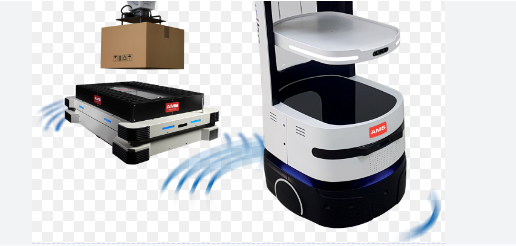
The Future Of Automated, Autonomous Mobile Robots
Automation has become an important factor in the workplace, and it has been streamlined to be much more efficient than before. The future of autonomous mobile robots is a promising one, as they will continue to produce quality results without any human input.
Outline for keywords:
-
Definition of Automated, Autonomous Mobile Robots
-
What are AMRs?
-
AMR History
-
How does an AMR Work?
-
Where are AMRs Used Today?
-
Future of Automated, Autonomous Mobile Robotics
Definition of Automated, Autonomous Mobile Robots
Mobile robots are machines that have the ability to move freely and independently. Historically, mobile robots were designed to be operated by a human operator. However, advances in technology have allowed for the development of mobile robots that are operated autonomously.
There are several types of autonomous mobile robots:
1) Mobile robot swarms:
These mobile robots are made up of many small, self-contained units that can act together as a single unit. These swarms can interact with their surroundings and navigate around obstacles using coordinated movements.
2) Mobile robot teams:
These mobile robots are composed of two or more units that work together to achieve a common goal. The team members can communicate with each other to coordinate their movements and actions.
3) Mobile robot platforms:
These mobile robots are designed to be used in specific situations or environments. They come equipped with sensors and additional hardware that allow them to interact with their surroundings and carry out specific tasks
What are AMRs?
AMRs are self-driving mobile robots designed to operate in a factory, warehouse, or other industrial setting. They are equipped with sensors and technology that allow them to navigate their surroundings and carry out tasks on their own.
The benefits of using AMRs include improved safety and efficiency. By automating certain tasks, AMRs can reduce the amount of time needed to complete a task by as much as 50%. In addition, they can help improve worker productivity by performing repetitive tasks faster than humans can.
There are several types of AMRs currently being developed, including small, handheld devices that can be used in factories or warehouses. Large autonomous machines that can navigate landscapes and perform complex tasks are also being developed, and could eventually be used in manufacturing plants or other industrial settings.
AMR History
The development of automated and autonomous mobile robots has been a long-standing goal of researchers and engineers. The possibilities that these machines present for performing tasks that are currently carried out by humans are vast, and there is no telling what applications they will eventually be used for.
One of the earliest attempts to develop mobile robots was made in the 1950s by Alexander Stepanovich Schelling. He designed a machine that could travel across a surface at a rate of two feet per second. However, this project never came to fruition due to technological limitations at the time.
In the 1970s, researchers at Carnegie Mellon University developed a robot known as Daisy which was capable of moving around autonomously on a tabletop. Daisy was used primarily for research purposes, but it paved the way for future developments in mobile robotics.
In 1986, Japanese researcher Masahiro Mori published a paper entitled “A Humanoid Robot That Can Navigate its Environment by Simultaneous Localization and Mapping”. This paper outlined the principles behind radar-based localization and mapping (RLM) which is now widely used in autonomousmobile robots.
In 1990, Hans Moravec developed an algorithm known as artificial neural networks (ANN) which is now widely used in mobile robotics applications. ANN allows machines to learn from experience and improve their performance over time.
In 1996, researchers at Honda Motor Company developed an autonomous minibot named ASIMO which was the first robot ever to be able to
How does an AMR Work?
AMRs are autonomous mobile robots that are designed to work alongside humans in various industrial settings. They are equipped with sensors and systems that allow them to navigate their surroundings and carry out tasks as required.
AMRs can be used for a variety of purposes, including manufacturing, maintenance, and transportation. They are able to operate autonomously or in tandem with human operators, and they can be adapted to specific environments.
AMRs have the potential to improve the efficiency of many industrial processes. They can help reduce labor costs, make work safer, and improve production levels. Additionally, AMRs can be used in emergency situations or during times of disruption to provide support to human employees.
Where are AMRs Used Today?
AMRs are being used in a wide range of industries today, from military and security applications to manufacturing and logistics. Here are a few examples:
1. Military and Security Applications
AMRs are widely used in military and security applications, including surveillance, reconnaissance, and weapon systems. They can be deployed in a variety of configurations, including as individual robots or as part of larger formations. AMRs are especially well-suited for missions that require high mobility and flexibility, such as search and rescue operations or perimeter defense.
2. Manufacturing and Logistics
AMRs are also being used in manufacturing and logistics settings. They can help improve efficiency by carrying out tasks that would otherwise be done manually, such as picking items off a production line or navigating around obstacles. AMRs can also help reduce the risk of accidents by monitoring workers’ surroundings continuously.
3. Retail Settings
AMR technology is also being adopted in retail settings. This is thanks in part to their ability to navigate autonomously through challenging environments such as cramped spaces or tall shelves. AMRs can also identify customer preferences quickly and carry out orders accordingly.
Future of Automated, Autonomous Mobile Robotics
The future of automated, autonomous mobile robotics is one in which robots are able to move around and interact with their surroundings without requiring human input. This technology has the potential to improve safety and efficiency in many industries, including manufacturing, healthcare, and transportation.
One of the key challenges facing automated mobile robotics is developing algorithms that can correctly recognize and respond to objects and obstacles in the environment. However, progress is being made on this front, as recent advances in machine learning show promise for improving robot navigation. In addition, advancements in AI are allowing robots to learn from experience and make adjustments on the fly. This enables them to navigate more effectively through complex environments.
Another area of development involves incorporating robotic technologies into vehicles. Automated driving systems have the potential to significantly reduce traffic congestion and save lives by understanding road conditions and reacting appropriately. While this technology remains nascent, there are a number of companies working on developing self-driving cars for widespread deployment.
Overall, automated mobile robotics has a bright future due to its ability to improve safety and efficiency across a variety of industries.


